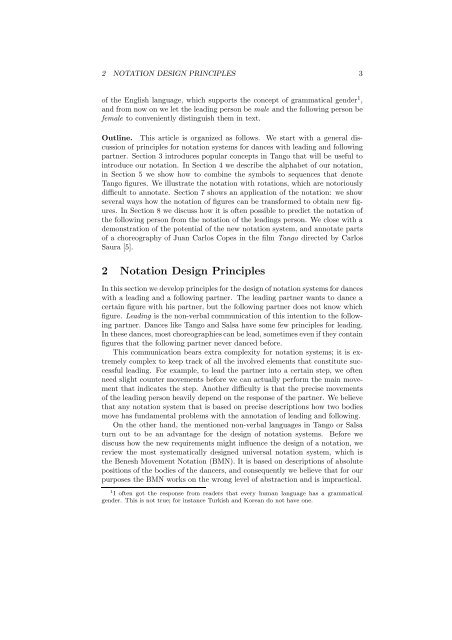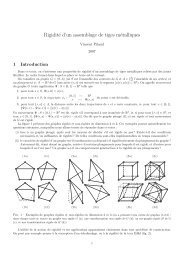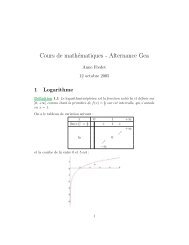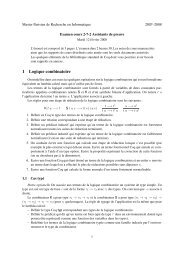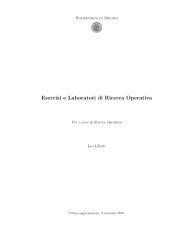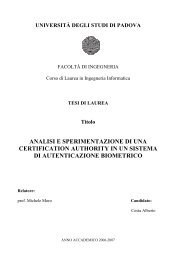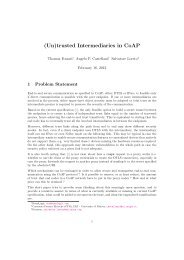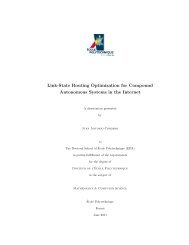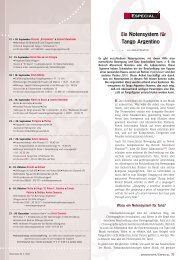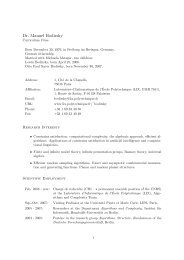You also want an ePaper? Increase the reach of your titles
YUMPU automatically turns print PDFs into web optimized ePapers that Google loves.
2 NOTATION DESIGN PRINCIPLES 3<br />
of the English language, which supports the concept of grammatical gender 1 ,<br />
and from now on we let the leading person be male and the following person be<br />
female to conveniently distinguish them in text.<br />
Outline. This article is organized as follows. We start with a general discussion<br />
of principles <strong>for</strong> notation systems <strong>for</strong> dances with leading and following<br />
partner. Section 3 introduces popular concepts in <strong>Tango</strong> that will be useful to<br />
introduce our notation. In Section 4 we describe the alphabet of our notation,<br />
in Section 5 we show how to combine the symbols to sequences that denote<br />
<strong>Tango</strong> figures. We illustrate the notation with rotations, which are notoriously<br />
difficult to annotate. Section 7 shows an application of the notation: we show<br />
several ways how the notation of figures can be trans<strong>for</strong>med to obtain new figures.<br />
In Section 8 we discuss how it is often possible to predict the notation of<br />
the following person from the notation of the leadings person. We close with a<br />
demonstration of the potential of the new notation system, and annotate parts<br />
of a choreography of Juan Carlos Copes in the film <strong>Tango</strong> directed by Carlos<br />
Saura [5].<br />
2 <strong>Notation</strong> Design Principles<br />
In this section we develop principles <strong>for</strong> the design of notation systems <strong>for</strong> dances<br />
with a leading and a following partner. The leading partner wants to dance a<br />
certain figure with his partner, but the following partner does not know which<br />
figure. Leading is the non-verbal communication of this intention to the following<br />
partner. Dances like <strong>Tango</strong> and Salsa have some few principles <strong>for</strong> leading.<br />
In these dances, most choreographies can be lead, sometimes even if they contain<br />
figures that the following partner never danced be<strong>for</strong>e.<br />
This communication bears extra complexity <strong>for</strong> notation systems; it is extremely<br />
complex to keep track of all the involved elements that constitute successful<br />
leading. For example, to lead the partner into a certain step, we often<br />
need slight counter movements be<strong>for</strong>e we can actually per<strong>for</strong>m the main movement<br />
that indicates the step. Another difficulty is that the precise movements<br />
of the leading person heavily depend on the response of the partner. We believe<br />
that any notation system that is based on precise descriptions how two bodies<br />
move has fundamental problems with the annotation of leading and following.<br />
On the other hand, the mentioned non-verbal languages in <strong>Tango</strong> or Salsa<br />
turn out to be an advantage <strong>for</strong> the design of notation systems. Be<strong>for</strong>e we<br />
discuss how the new requirements might influence the design of a notation, we<br />
review the most systematically designed universal notation system, which is<br />
the Benesh Movement <strong>Notation</strong> (BMN). It is based on descriptions of absolute<br />
positions of the bodies of the dancers, and consequently we believe that <strong>for</strong> our<br />
purposes the BMN works on the wrong level of abstraction and is impractical.<br />
1 I often got the response from readers that every human language has a grammatical<br />
gender. This is not true; <strong>for</strong> instance Turkish and Korean do not have one.


